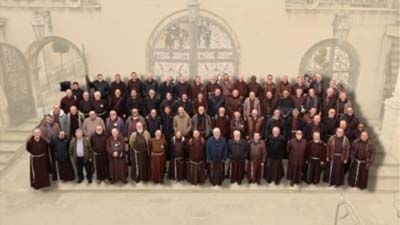The Order was founded around 1525, when the Franciscan friar Matteo da Bascio - ordained priest in the Marche region, Italy - was convinced that the lifestyle led by the Franciscans of his time was not what Saint Francis had imagined. He wished to return to the original lifestyle in solitude and penance as practiced by the founder of his order.
His superiors tried to suppress these new notions, and thus Matteo and his first companions were forced to hide from the Church authorities, who wanted to arrest them for abandoning their religious obligations. These were the years of the Lutheran Reformation and, therefore, any attempt at renewal was badly regarded by the superiors of the religious orders. Matteo and his friends found refuge with the Camaldolese monks; in gratitude, they subsequently adopted the hood worn by that order, which was the hermit's mark in the Marche region, in addition to wearing a beard. The popular name of their movement originates from this characteristic of their habit.
In 1528, with the mediation of Caterina Cibò, Duchess of Camerino, Matteo obtained the approval of Pope Clement VII with the bull Religionis zelus. He was given permission to live as a hermit and to go everywhere preaching to the poor. And this permission was not only for him, but for all those who would join him in his attempt to restore the most literal observance possible of the rule of St. Francis. Matteo and the original group were soon joined by others and initially they were called Friars Minor of the Hermetical Life and due to the opposition of the Observants, they became the congregation: the Friars Minor Hermits, a branch of the Conventual Franciscans, but with their own vicar. A difficult period was encountered in 1542, when the Vicar General of the Order, Bernardino Ochino, joined the Protestant Reformation.
Pope Gregory XIII, in 1574, allowed the Order to settle in "France and all other parts of the world and to erect houses, places, Custodies and Provinces", authorizing, in fact, its diffusion outside Italy. In the 16th century, the Capuchins numbered about 14,000 friars with nearly 1,000 friaries. The order’s numbers would further increase between 1600 and the mid-1700s. Eventually, they would reach 34,000 friars and 1,700 friaries. These were also the years in which the Order modified, or rather, perfected some of its initial characteristics. While remaining faithful to the vow of radical poverty, the Capuchins had shown themselves to be excellent preachers; and this, given the initial relationships with the Conventual branch, led to a "conventualization". This process was also supported by the Holy See, which in those years urged religious orders to suppress lesser or undersized religious houses, convinced that by encouraging larger local fraternities, they could be better controlled. The initial small shelves of books became real libraries, necessary to ensure good training for preachers. To understand the role of the order during this century and a half period, consider Alessandro Manzoni’s choice of a Capuchin, Br. Cristoforo, to oppose Don Rodrigo in his Promessi Sposi (The Betrothed). The Capuchins were also very active in the missions: for example, as Pellegrino da Forlì reports, the Indian archdiocese of Agra was entrusted to the brothers of the order since 1703.


Order of Friars Minor Capuchin, Via Piemonte, 70 00187, Roma, ITALIA
Via Piemonte, 70 00187, Roma, ITALIA
Phone: +390642011710
Email: Mail us
Web: https://www.ofmcap.org/en/